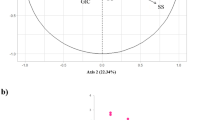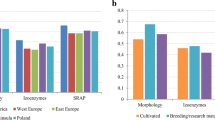Abstract
Asturias is a region of North of Spain where the cultivation of the escanda (Triticum spelta L.) is maintained since the antiquity with traditional systems. Twenty-six spelt populations collected during the summer of 2004 in this Spanish region were analysed for spikes morphology and high-molecular-weight glutenin subunits (HMWGs) composition. Spikes of each population were characterised by ten qualitative traits based in the UPOV’s descriptors, which has permitted to detect five botanical varieties together with two plant groups not previously described. The loss of two botanical varieties described in old works on this crop in this zone has been observed. The inter- and intra-population distribution of these spike characters and HMWGs alleles were investigated. The results show that the genetic variation is mainly present within populations, being the variation among populations only 17.6%, which could be due to exchange of material among the farmers. All data suggest the urgent necessity to establish a conservation system (both ex situ and on farm) with the purpose of safeguard of genetic diversity of this crop.

Similar content being viewed by others
References
Alvarez JB, Caballero L, Martín LM (2007) Variability for morphological traits and high-molecular-weight glutenin subunits in Spanish spelt lines. Plant Genetic Resources: Characterization and Utilization (in press), doi:10.1017/s1479262107826098
Alvarez JB, Martín A, Martín LM (2001) Variation in the high molecular weight glutenin subunits coded at the Glu-H ch 1 locus in Hordeum chilense. Theor Appl Genet 102:134–137
Alvargonzalez C (1908) La escanda, su origen y su cultivo. Gijón/Spain
An X, Li Q, Yan Y, Xiao Y, Hsam SLK, Zeller FJ (2005) Genetic diversity of European spelt wheat (Triticum aestivum ssp. spelta L. em. Thell.) revealed by glutenin subunit variations at the Glu-1 and Glu-3 loci. Euphytica 146:193–201
Caballero L, Martín LM, Alvarez JB (2001) Allelic variation of the HMW glutenin subunits in Spain accessions of spelt wheat. Theor Appl Genet 103:124–128
Caballero L, Martín LM, Alvarez JB (2004a) Intra- and interpopulation diversity for HMW glutenin subunits in Spanish spelt wheat. Genet Resour Crop Evol 51:175–181
Caballero L, Martín LM, Alvarez JB (2004b) Genetic variability of the low-molecular-weight glutenin subunits in spelt wheat (Triticum aestivum ssp. spelta L. em. Thell.). Theor Appl Genet 108:914–919
Caballero L, Martín LM, Alvarez JB (2004c) Variation and genetic diversity for gliadins in Spanish spelt wheat accessions. Genet Resour Crop Evol 51:679–686
Caballero L, Martín LM, Alvarez JB (2007) Agrobiodiversity of hulled wheats in Asturias (North of Spain). Genet Resour Crop Evol 54:267–277
IPGRI (2002) Neglected and underutilized plant species: Strategic Action of the International Plant Genetic Resources Institute. International Plant Genetic Resources Institute, Rome, Italy
Kerber ER, Rowland GG (1974) Origin of the free-threshing character in hexaploid wheat. Can J Genet Cytol 16:145–154
Laemmli UK (1970) Cleavage of structural proteins during the assembly of the head of bacteriophage T4. Nature 227:680–685
Marshall DR, Brown AHD (1975) Optimum sampling strategies in genetic conservation. In: Frankel OH, Hawkes JG (eds) Crop genetic resources for today and tomorrow. Cambridge University Press, Cambridge, pp 53–70
McFadden ES, Sears ER (1946) The origin of Triticum spelta and its free-theshing hexaploid relatives. J Hered 37:81–87
Nei M (1973) Analysis of gene diversity in subdivided populations. Proc Natl Acad Sci USA 70:3321–3323
Peña-Chocarro L (1996) In situ conservation of hulled wheat species: the case of Spain. In: Padulosi S, Hammer K, Heller J (eds) Hulled wheats. International Plant Genetic Resources Institute, Rome, pp 129–146
Szabó AT, Hammer K (1996) Notes on the taxonomy of farro: Triticum monococcum, T. dicoccon and T. spelta. In: Padulosi S, Hammer K, Heller J (eds) Hulled wheats. International Plant Genetic Resources Institute, Rome, pp 2–39
Tellez-Molina R, Alonso-Peña M (1952) Los trigos de la Ceres Hispanica de Lagasca y Clemente. Instituto Nacional de Investigaciones Agronómicas, Madrid
UPOV (1994) Draft guidelines for the conduct of test for distinctness, homogeneity and stability (wheat).TG/3/11 (proj), 32 pp
Acknowledgements
This research was supported by grant AGL2004-03361-C02-01 from the Spanish Ministry of Education and Science and the European Regional Development Fund (FEDER) from the European Union. We would like to thank the Asturian farmers for their kindly collaboration during the collecting mission.
Author information
Authors and Affiliations
Corresponding author
Rights and permissions
About this article
Cite this article
Caballero, L., Martín, L.M. & Alvarez, J.B. Genetic diversity in Spanish populations of Triticum spelta L. (escanda): example of an endangered genetic resource. Genet Resour Crop Evol 55, 675–682 (2008). https://doi.org/10.1007/s10722-007-9271-0
Received:
Accepted:
Published:
Issue Date:
DOI: https://doi.org/10.1007/s10722-007-9271-0




